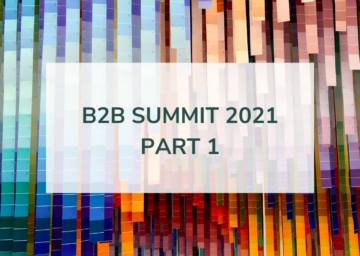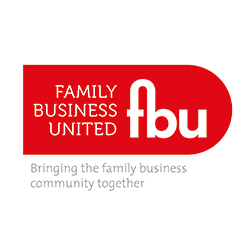PR Week and the B2B Summit 2021: Driving growth in B2B (Part 2)
29th November 2021 / All, Blog

In this final instalment of our two-part series, we’re reviewing the outstanding content from this year’s B2B Summit, where expert speakers highlighted some of the key changes in the marketing and communications landscape, discussed how they have adapted to these new pressures, and indicated what we as B2B practitioners can do to stay ahead of the game.
In this post, well be looking at the following talks:
- Getting to grips with the new generation of B2B marketing: from the robot revolt to revolutionising ABM
- RO-Why? Looking beyond measurement and ROI
- Talent Tinder: Do you need to break up with your tech?
- Booming BETAs and the rise of tech-native buyers
We hope you enjoy it as much as we did, and in case you missed it, be sure to check out part one. And, you can still buy an on-demand ticket to watch the B2B Summit in full.
- Getting to grips with the new generation of B2B marketing: from the robot revolt to revolutionising ABM
Speaker: Zoe Hominick – Head of Business Marketing and CEX at O2 Business
In the technical world that we live in today, how can ABM help you achieve personalisation in what is an increasingly humanised B2B world?
ABM starts with the customer. Personalisation is critical, and to achieve that in a B2B world you have to do 3 things:
- Start from the customer out – stay true to the needs of the individual, tailor your offer to the challenges you see
- Personalise beyond the organisation to the individual – build relationships with the individuals behind the accounts, not the accounts themselves
- Personalisation is a two-way street – consider the customer’s perspective and their understanding of you.
With the rapid shift to digital we’ve seen over the last 18 months, how can marketing and sales work together?
Digital and social engagement are nothing new, but we’ve really started seeing the importance of digital success in the past 18 months. Remember that ABM is something you do with sales, not to sales. Help the sales teams you’re working with to expand their presence, make sure your goals are aligned, and send out content that will not only provide a presence but will help them to truly engage.
“Look through different lenses to gain insight into your customers so that you get a dynamic and creative approach. After you’ve empowered your sales teams – you’ve upskilled them, you’ve given them the content, you’ve given them the insights – support them to engage so that you’re able to continually track and refine your joint approach.” – Zoe Hominick
As ever, ABM is about understanding your business goals and then ensuring your marketing approach is tailored to that. ABM continues to be as powerful and as important a part of the mix as it’s ever been, and it’s really relevant in B2B marketing today.
Key takeaways:
- Make clear decisions on who you’re targeting and why
- Move beyond the organisation to the individual
- Remember that ABM is part of a broader mix of marketing tools. It’s powerful, but it can’t do the whole job alone
- AMB is never going to be a replacement for brand awareness.
2. RO-Why? Looking beyond measurement and ROI
Speaker: Barnaby Barron – Head of UK Analysis, Board Director at Cision Insights
Measurement has always had a prominent place in B2B marketing, but should it be taking more of a backseat?
Before you undertake an activity, you need an understanding of what it is you’re going to measure.
There are four steps to measuring ROI:
- Measurements start around your inputs, i.e., activities you’re undertaking within earned, paid, and social media etc.
- Once you have those in place, you want to be measuring and tracking the outputs of those, i.e., what’s your volume of content, and how many people have you reached on social media?
- After that, you want to be able to track your outtakes, like audience engagement: Is content being shared on social media? Is brand awareness being impacted? Has the campaign improved opinion among particular demographics?
- Finally, look at outcomes: Have your efforts increased traffic on your website? Have there been notable increased product sales?
A lot of times, programs will focus on their inputs and outputs, but that doesn’t tell you a huge amount. Focusing on outtakes and outcomes, on the other hand, will help you identify where and when your audience is engaging.
But ROI can become dangerous. Brands and businesses often lean into a single ROI metric, which will tell them when everything is going well, but when things start declining, there isn’t enough information to tell them where it went wrong or how they can fix it.
The holy grail, therefore, is to achieve ‘actionable insights’, rather than just ROI and measurement. This will give you the solutions to problems that arise.
Key takeaways:
- Know how to communication to your stakeholders
- Monitoring and analysis are foundational, but go beyond that. It’s the outcomes and outtakes that will provide insights into improving performance and seeing results.
Don’t miss Part 1 of this B2B Summit series.
3. Talent Tinder: Do you need to break up with your tech?
Speakers: Sarah Jenkins – Managing Director at Saatchi & Saatchi. Scott Allen – Microsoft Global Marketing Development & Strategy Director at Microsoft. Nicola Pestell – Director at The Octopus Group.
Tech vs talent debate – are marketing teams at risk of neglecting talent in favour of becoming lazy and relying on tech?
“The relationship between marketers and AIs should be a supportive one. It’s about finding balance – insights are how we as marketers optimise our impact, but if we combine that with hindsight and foresight, we can start making better-informed decisions moving forward. As marketers we need to learn from the data AI can provide in order to move forwards into a digital future” – Scott Allen.
“The alchemy of science and creativity is only going to get deeper and richer. It’s never been a more extraordinary time to be a marketer, and the science is bringing rigour and intelligence, which we need now more than ever. The creativity allows us to accelerate and to bring magic and energy into what we’re doing” – Sarah Jenkins.
Do marketers need to master tech before it masters us?
“As with anything, you need a strategy and a plan to operate tech successfully. That’s what will keep you focused and driving forwards rather than allowing tech innovations to drive your decisions.
“Ultimately, it’s our job as marketers to stay curious, so there’s no sense in backing down from the challenge ahead. Strategic hiring certainly comes into play – getting a blend of scientists and creatives to maintain a healthy balance. We’ve also got to do a better job at evaluating our tech investment, thinking about how they’re working for us instead of how we’re working for them. So no, we don’t need to master tech, but we do need to stay on top of things and make sure we understand what it is we’re investing in” – Sarah Jenkins.
How can marketers be expected to effectively utilise tech if leadership is disconnected from that technology?
“In the last 18 months, leadership have really changed the way they view the tech within the marketing teams, potentially because B2B buyers are demanding a more digital experience within the sales process. In order to do that, the tech platforms have to be there and have to be talking to each other. Leadership has to consider how they prove the budget and the ROI to use those platforms and put them in place.
“B2B marketers are still struggling with the platforms they currently use but don’t fully understand. Marketing leaders, therefore, have to understand that you don’t just put these platforms in place, they take time to build up, grow, and work for the marketers instead of the other way round. It’s the expectations that are slowly changing.
“It’s going to be interesting to watch over the next five years as the B2B buyers become more digital savvy, and in turn, we as B2B marketers have to move our approach to more extensive platforms. We’re going to have to be just as creative as we are analytical because all of these platforms require creativity to get the most out of them” – Nicola Pestell.
Don’t miss Part 1 of this B2B Summit series.
4. Booming BETAs and the rise of tech-native buyers
Speaker: Stefan Doering – Brand Strategy Lead at PWC.
The term ‘BETA’ was coined by the LinkedIn B2B institute, and it’s used to describe the current workforce (21-40yo) of people who grew up as digital natives. It stands for:
B – Blurred boundaries (between work and life, personal and professional)
E – Evolving (identities, as well as personal/professional brand)
T – Tech-native
A – Activist (BETAs care, and they want the brands they work with to care too).
It’s all about being constantly evolving, innovating, adaptable, and yes, tech-savvy. The B2B workforce is changing as tech-native buyers move into more senior positions. On this, there are a couple of things to bear in mind for marketers who want to alter their strategies to suit this new tech-savvy breed of buyers.
The first: tap into the cultural mindset of BETAs and ask how can we communicate things that are important to them? We know that their boundaries between professional and personal lifestyles are blurred, that they’re feeling time-poor, and that there’s no distinction between their personal brand and their professional identities. As a marketeer, it’s really important to cut through the noise and be accessible to this audience. That means creating ‘snackable’ content and positioning it where BETAs are going to see it.
The other thing is social media. It’s not about simply putting your brand campaigns on all the social media platforms, but it’s about trying to drive that personal connection. Business is still so much about relationships, and for BETAs it’s no different. Only the manner of connecting has changed, and so we need to start thinking about how we can form these tech-first relationships. BETAs want meaningful conversations, and if your brand can tap into their need and cultural mindset, that becomes a really powerful formula.
A couple of key points on messaging and tone:
- The tone needs to be very real and human. Authentic communication is important (and is that really so different to how we communicating to other audiences?). While the tone might change, the messaging is universal.
- It’s always important to define your audience, i.e., are you selling to existing buyers or BETAs? It should always be human, and always carry a consistency of brand, but of course when you target it to different types of buyers you want to tailor your channel strategy accordingly, whether that’s digital media, social media, or your ABM (etc).
Missed Part 1 of this B2B Summit series? Be sure to head over and check it out for our overview of the following talks:
- Pivoting PR: transforming your strategy to stay human in an age of digitisation
- Do B2B comms professionals and clients actually care about brand purpose?
- Snackable content: making comms easily digestible
- Diversity and inclusion in b2b comms: where are we going wrong?
- Cultivating creativity: why B2B is boring no more
Access to each B2B Summit talk is available on-demand until December 23rd from PR Week.













